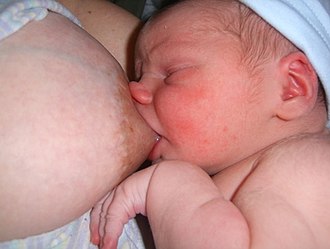Lactational amenorrhea
(Redirected from Breastfeeding infertility)
Lactational Amenorrhea
Lactational amenorrhea is the natural postpartum infertility that occurs when a woman is amenorrheic (not menstruating) and fully breastfeeding. It is a method of birth control that relies on the natural postpartum infertility that occurs when a woman is breastfeeding.
Physiology
Lactational amenorrhea is based on the hormonal changes that occur during breastfeeding. When a baby suckles at the breast, it stimulates the release of prolactin and oxytocin from the pituitary gland. Prolactin is responsible for milk production, while oxytocin causes the milk ejection reflex or "let-down". High levels of prolactin suppress the release of gonadotropin-releasing hormone (GnRH) from the hypothalamus, which in turn reduces the secretion of luteinizing hormone (LH) and follicle-stimulating hormone (FSH) from the pituitary gland. This suppression of LH and FSH prevents ovulation and menstruation.
Criteria for Effectiveness
For lactational amenorrhea to be an effective method of contraception, certain criteria must be met:
- The mother must be exclusively breastfeeding, meaning the infant receives no other food or drink besides breast milk.
- The infant must be less than six months old.
- The mother must be amenorrheic, meaning she has not yet resumed menstruation.
If these conditions are met, lactational amenorrhea can be more than 98% effective as a contraceptive method.
Factors Affecting Lactational Amenorrhea
Several factors can influence the effectiveness of lactational amenorrhea:
- Frequency of breastfeeding: Frequent breastfeeding sessions, both day and night, help maintain high levels of prolactin.
- Duration of breastfeeding sessions: Longer breastfeeding sessions can enhance the suppression of ovulation.
- Introduction of supplementary feeding: Introducing formula or solid foods can reduce the frequency of breastfeeding and decrease the effectiveness of lactational amenorrhea.
- Breastfeeding technique: A poor breastfeeding latch, as shown in the image, can affect milk transfer and hormonal responses, potentially reducing the effectiveness of lactational amenorrhea.
Advantages and Disadvantages
Advantages
- Natural and cost-free: Lactational amenorrhea is a natural method of contraception that does not require any medical intervention or cost.
- Health benefits for mother and child: Breastfeeding provides numerous health benefits for both the mother and the infant, including nutritional, immunological, and emotional benefits.
Disadvantages
- Limited duration: The effectiveness of lactational amenorrhea diminishes after six months or when menstruation resumes.
- Requires strict adherence: The method requires strict adherence to breastfeeding practices, which may not be feasible for all mothers.
Related Pages
Transform your life with W8MD's budget GLP-1 injections from $125.
W8MD offers a medical weight loss program to lose weight in Philadelphia. Our physician-supervised medical weight loss provides:
- Most insurances accepted or discounted self-pay rates. We will obtain insurance prior authorizations if needed.
- Generic GLP1 weight loss injections from $125 for the starting dose.
- Also offer prescription weight loss medications including Phentermine, Qsymia, Diethylpropion, Contrave etc.
NYC weight loss doctor appointments
Start your NYC weight loss journey today at our NYC medical weight loss and Philadelphia medical weight loss clinics.
- Call 718-946-5500 to lose weight in NYC or for medical weight loss in Philadelphia 215-676-2334.
- Tags:NYC medical weight loss, Philadelphia lose weight Zepbound NYC, Budget GLP1 weight loss injections, Wegovy Philadelphia, Wegovy NYC, Philadelphia medical weight loss, Brookly weight loss and Wegovy NYC
|
WikiMD's Wellness Encyclopedia |
| Let Food Be Thy Medicine Medicine Thy Food - Hippocrates |
Medical Disclaimer: WikiMD is not a substitute for professional medical advice. The information on WikiMD is provided as an information resource only, may be incorrect, outdated or misleading, and is not to be used or relied on for any diagnostic or treatment purposes. Please consult your health care provider before making any healthcare decisions or for guidance about a specific medical condition. WikiMD expressly disclaims responsibility, and shall have no liability, for any damages, loss, injury, or liability whatsoever suffered as a result of your reliance on the information contained in this site. By visiting this site you agree to the foregoing terms and conditions, which may from time to time be changed or supplemented by WikiMD. If you do not agree to the foregoing terms and conditions, you should not enter or use this site. See full disclaimer.
Credits:Most images are courtesy of Wikimedia commons, and templates, categories Wikipedia, licensed under CC BY SA or similar.
Translate this page: - East Asian
中文,
日本,
한국어,
South Asian
हिन्दी,
தமிழ்,
తెలుగు,
Urdu,
ಕನ್ನಡ,
Southeast Asian
Indonesian,
Vietnamese,
Thai,
မြန်မာဘာသာ,
বাংলা
European
español,
Deutsch,
français,
Greek,
português do Brasil,
polski,
română,
русский,
Nederlands,
norsk,
svenska,
suomi,
Italian
Middle Eastern & African
عربى,
Turkish,
Persian,
Hebrew,
Afrikaans,
isiZulu,
Kiswahili,
Other
Bulgarian,
Hungarian,
Czech,
Swedish,
മലയാളം,
मराठी,
ਪੰਜਾਬੀ,
ગુજરાતી,
Portuguese,
Ukrainian
Contributors: Prab R. Tumpati, MD

